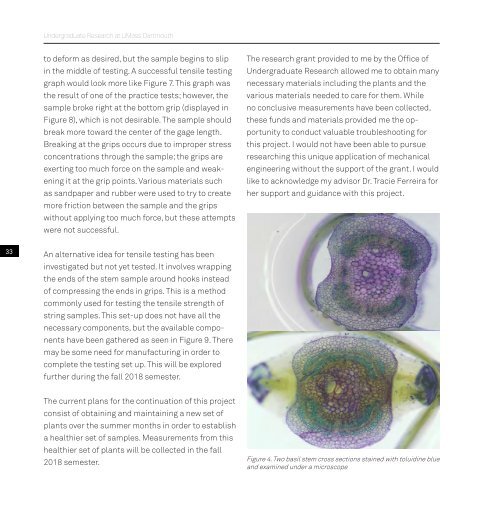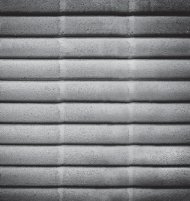Undergrad_Book_16-18_Pge_View_Print_no print marks_compressed
You also want an ePaper? Increase the reach of your titles
YUMPU automatically turns print PDFs into web optimized ePapers that Google loves.
<strong>Undergrad</strong>uate Research at UMass Dartmouth<br />
to deform as desired, but the sample begins to slip<br />
in the middle of testing. A successful tensile testing<br />
graph would look more like Figure 7. This graph was<br />
the result of one of the practice tests; however, the<br />
sample broke right at the bottom grip (displayed in<br />
Figure 8), which is <strong>no</strong>t desirable. The sample should<br />
break more toward the center of the gage length.<br />
Breaking at the grips occurs due to improper stress<br />
concentrations through the sample; the grips are<br />
exerting too much force on the sample and weakening<br />
it at the grip points. Various materials such<br />
as sandpaper and rubber were used to try to create<br />
more friction between the sample and the grips<br />
without applying too much force, but these attempts<br />
were <strong>no</strong>t successful.<br />
The research grant provided to me by the Office of<br />
<strong>Undergrad</strong>uate Research allowed me to obtain many<br />
necessary materials including the plants and the<br />
various materials needed to care for them. While<br />
<strong>no</strong> conclusive measurements have been collected,<br />
these funds and materials provided me the opportunity<br />
to conduct valuable troubleshooting for<br />
this project. I would <strong>no</strong>t have been able to pursue<br />
researching this unique application of mechanical<br />
engineering without the support of the grant. I would<br />
like to ack<strong>no</strong>wledge my advisor Dr. Tracie Ferreira for<br />
her support and guidance with this project.<br />
33<br />
An alternative idea for tensile testing has been<br />
investigated but <strong>no</strong>t yet tested. It involves wrapping<br />
the ends of the stem sample around hooks instead<br />
of compressing the ends in grips. This is a method<br />
commonly used for testing the tensile strength of<br />
string samples. This set-up does <strong>no</strong>t have all the<br />
necessary components, but the available components<br />
have been gathered as seen in Figure 9. There<br />
may be some need for manufacturing in order to<br />
complete the testing set up. This will be explored<br />
further during the fall 20<strong>18</strong> semester.<br />
The current plans for the continuation of this project<br />
consist of obtaining and maintaining a new set of<br />
plants over the summer months in order to establish<br />
a healthier set of samples. Measurements from this<br />
healthier set of plants will be collected in the fall<br />
20<strong>18</strong> semester.<br />
Figure 4. Two basil stem cross sections stained with toluidine blue<br />
and examined under a microscope



